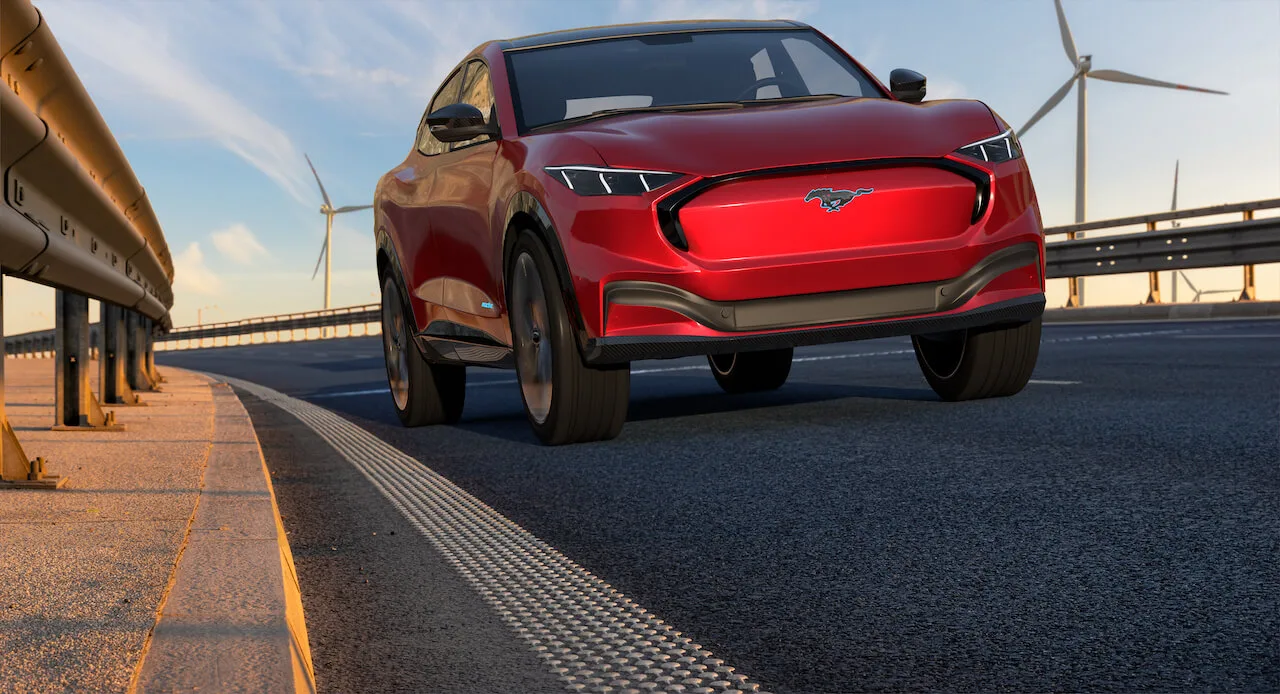
People have strong opinions on EVs—some of which are based on bad information. So, to clear the air, we’re rolling up with the facts on some of the most common claims surrounding electric vehicles.
MICHIGAN—On TV screens, in Michigan factories, and on the road, we’re seeing more vehicles that run on electricity, not gas. In the second quarter of 2021, EV sales accounted for 5.6% of all new car sales in the US—the highest share ever. By 2030, federal officials expect 50% of new cars sold to be electric.
But for one reason or another, potential buyers still have their doubts about Michigan’s electric future.
Here are the facts:
CLAIM: Electric vehicles are too expensive for the average Michigander.
That’s mostly untrue.

Here’s an example: The Chevy Bolt starts at $29,600. With average credit and a 10% down payment, an average monthly payment for one would be about $455. The median household income in Michigan is $59,234, according to the latest US Census statistics. Economists suggest putting no more than 10% of your annual income toward the purchase of a new vehicle—which would be about $5,923 in Michigan. The Chevy Bolt payment plan outlined above would equate to about $5,460 in annual payment costs.
That (barely) fits the budget.
It’s worth noting: Some households need more than one vehicle.
It’s worth noting: This figure does not account for gas savings. EPA calculations show that charging your vehicle is still almost always going to cost less than pulling up to the pump. That results in long-term savings on fuel costs that you would otherwise be spending by driving a gas-powered car.
It’s worth noting: The average price that Americans paid for a new car in July 2022 was $48,182, according to Kelley Blue Book. There are many electric vehicles priced below that mark—meaning it’s not necessarily more expensive to find an electric alternative.
It’s worth noting: There are tax credits for buying EVs. Under the Inflation Reduction Act—which Biden signed this month—a tax credit worth up to $7,500 for buyers of new EVs and hybrids has been extended through 2032. A separate $4,000 tax credit is also available on used models. To get the tax credit, the retail price of those vehicles cannot exceed $80,000 for SUVs, trucks and vans or $55,000 for sedans. It would also be unavailable to those who make more than $150,000 annually—or $300,000 for couples who file jointly. Used EV credits also carry income caps: $75,000 individually or $150,000 for couples.
CLAIM: The cost of charging an EV is the same (if not more) than gas.
That’s false.
According to the EPA, switching to an EV could save your household approximately $500–$1,000 in fuel costs per year. More specifically, the EPA calculates that it costs about $1.94 to travel 25 miles in a gas-powered Toyota Prius, which logs more than 50 miles per gallon, compared to $0.91 in a Chevy Bolt.
It’s worth noting: Plenty of EVs have all-wheel drive to handle those tough Michigan winters.
It’s worth noting: The jury is still out on whether EVs have lower maintenance costs than their gasoline-powered counterparts. Data from the EPA suggests EVs may be cheaper in the long run, but some EV repairs may still prove more costly, at least while this market is in its infancy.
CLAIM: You need to buy a pricey charging station.
That’s false.
If your home already has a 240-volt circuit available, the basic installation will only reportedly run you between $250 and $400. Just plug it in when you park, and you’ll be fueled up.
It’s worth noting: Electricity rates can vary depending on where you live, and what time of day you’re using your at-home charger. Rates tend to be lower during the evening hours when usage is low.
It’s worth noting: Speedier charging stations, which are an optional feature on most EVs, come with heftier price tags. Level 2 chargers reportedly cost up to $2,000. Level 3 chargers? Up to $50,000.
It’s worth noting: A Chevy Bolt EV would take seven hours to charge at home on a Level 2 charger. The Nissan Leaf EV takes an hour more. A Mini SE Hardtop is your best bet at five hours. Downgrade to a Level 1 charger and you’re looking at a full day’s charge. Dish out the money on a Level 3 charger and you can restore 80% of the battery in as little as 30 minutes.
CLAIM: The batteries only last a couple years.
That’s false.
Every battery in an electric car sold in the U.S. comes with a warranty that lasts for at least eight years or 100,000 miles, says CarFax. Research suggests that the average battery will last up to 200,000 miles, which is about the same lifespan as a gas-powered transmission.
It’s worth noting: Electric cars—and their batteries—sold in the United States are required to pass the same sorts of safety testing and standards as those of conventional, gas-powered cars.
CLAIM: EVs are luxury items—not for average, working-class Americans.

That’s mostly true—for now. The Chevy Bolt package outlined above includes bottom-barrel stock options on one of the cheapest electric vehicles on the market. Business Insider recently reported that the average electric vehicle will set you back about $54,000, while the average gasoline vehicle costs about $44,000. Both of these options are out of reach for the average Michigander.
It’s worth noting: The $7,500 federal tax credit wrapped into the Inflation Reduction Act includes EV models like the 2022 Ford F Series electric pickup, BMW X5, Nissan Leaf, Chevrolet Bolt, Jeep Wrangler plug-in hybrid, and all four Tesla models. But some models may exceed sticker-price limits in the complex new law, and it remains to be seen whether automakers will be able to find the minerals or manufacture batteries that can actually qualify for the credits.
It’s worth noting: You can click here and key in the 17-digit vehicle identification number of the EV you want to buy to make sure it’s made in the US, Canada or Mexico. The Treasury Department also released a frequently asked questions page on the new law’s provisions. Tax credits are no longer available for vehicles assembled outside of the US, Canada or Mexico—but those who signed purchase contracts for EVs before Aug. 16, 2022 could still get the credits.
It’s worth noting: Michigan has one of the highest disincentives in the form of its EV registration fees, NPR reports. The state collects taxes for roads through vehicle registration fees, a fuel tax, plus sales tax on top of that fuel purchase. Since fully electric vehicles do not use gas, the state charges additional registration fees to make up some of the difference. Those fees went up at the start of this year. They amount to some of the highest EV registration fees in the nation.
It’s worth noting: The price of EVs is expected to steadily decline in the next few years, as the supply chains, materials required, and workforce become finer-tuned to the still very-new market. Ford’s CEO Jim Farley recently said it currently costs much more to build an electric vehicle than one that relies on a traditional gas engine, according to the Associated Press.
It’s worth noting: In April, Gov. Gretchen Whitmer proposed electric vehicle incentives in her State of the State address in the form of a $2,000 rebate for a new electric vehicle and $500 rebate for at-home charging infrastructure that can be paired with the $7,500 federal tax credit— knocking nearly $10,000 off the price of a new electric car. Two bills set to establish those rebate incentives have been referred to a committee and are currently awaiting a hearing.
There are two other key financial incentives available to Michiganders too:
Charging Station Rebates
DTE Energy, Great Lakes Energy and Consumers Energy offer $500 rebates to residential customers (and up to $5,000 for commercial customers) who install Level 2 or direct current fast charging stations. They are available on a first-come, first-serve basis at Consumers via PowerMIDrive website. DTE’s rebate is only available to customers who enroll in the EV Charging Rates program. Click here for more details about the Great Lakes Energy program.
The Holland Board of Public Works also offers residential customers a $300 rebate for the purchase of Level 2 EV charging stations. See the HBPW rebates webpage for details.
Time-Of-Use Rates
Indiana Michigan Power, the Lansing Board of Water & Light, the Holland Board of Public Works, and DTE Energy each offer a variable rate to residential customers who own a qualified EV, which means the electricity rate is adjusted depending on the time of the day that the energy is actually being used. For more information, see the Indiana Michigan Power, DTE Charging Forward, Lansing Board of Water & Light and Holland Board of Public Works webpages.
CLAIM: I only buy American products. There aren’t any American-made EVs.
That’s false.
There are plenty of electric vehicles being manufactured stateside, and those companies are expanding their EV production footprint in the US all the time. But history does show the US has lagged behind other countries in manufacturing EVs and their components.
Studies show more than 10 million electric passenger vehicles were built between 2010 and 2020. In 2018, US automakers had churned out just 20% of the global stock, reports CNBC. And by 2020, US automakers represented even less—only 18% of the cumulative number of EVs produced since 2010. Meanwhile, shares of EV production rose in China and Europe.
It’s worth noting: The US is the latest country to cross what’s become a critical EV milestone: 5% of new car sales are now electric, Bloomberg reports. Experts say this threshold is a sign of mass EV adoption. As more people make the switch, more production will come along with it.
It’s worth noting: Michigan has cemented itself as a powerplayer in the global EV manufacturing game—including a raft of generous tax incentives to spur the construction of new EV factories. But, while Michigan has lured battery plants in Delta Township and Holland, and assembly plants in Detroit and Orion township, the state has also lost out on several major investments. Those include when Ford and GM opted for Tennessee and Kentucky, respectively.
CLAIM: There aren’t enough chargers to conveniently travel in Michigan.
That’s mostly false—unless you’re really trying to get lost.
This US Department of Energy map shows just how many EV chargers there are across Michigan. And unless you’re traveling circles around some rural stretches of northeast Michigan, or venturing deep into the Upper Peninsula wilderness without stopping along the way, you should get around just fine.
And just like how costs will come down, and more EVs will be produced in America, the network of charging systems is also projected to continue expanding as more Americans buy EVs.
After all, we managed to build enough gas stations, didn’t we?
It’s worth noting: The US has a target to install 500,000 public chargers by 2030 that anyone (and any car) can use. Funding for that project is already secured under the Bipartisan Infrastructure Law. But a McKinsey study says more is needed: If half of new cars are EVs by 2030, the US should have 1.2 million public chargers to augment a growing private network.
CLAIM: The battery range is too low to conveniently travel anywhere.
That’s mostly false—unless you have some strange traveling habits.
The average EV had a range of more than 250 miles in 2021. Technology has only improved since then, including some models that can push 400 miles. That means you can conveniently charge and travel between just about any city in Michigan—including the all-day Up North road trips. Bonus: Some EVs with the longest range (520 miles!) also happen to have all-wheel drive.
One example:
Most EVs would take you on this full 202-mile trip from Marquette, across most of the Upper Peninsula and across the Mighty Mack to Petoskey on a single charge—with some breathing room to stop and putter along the way.
You would pass by at least a dozen charging stations along this trip, too.
CLAIM: I need my pickup truck—and there aren’t any heavy duty EV pickups.
False.
The 2022 F-150 Lightning—which is already sold out—has a towing capacity of 7,700 pounds. Chevy’s new Silverado EV has 660 horsepower and 780 foot-pounds of torque. Rivian’s fancy new pickup truck can tow up to 11,000 lbs and go from 0-60 mph in less than 4 seconds.
And there are plenty of other electric pickup trucks on the horizon.
It’s worth noting: Retail availability on EV pickups is extremely limited, so if you want one, it pays to reserve the chance to order one early.
It’s worth noting: The GMC Hummer EV Pickup is being built in Detroit. In April, production began in Dearborn on the Ford F-150 Lightning EV truck.
CLAIM: EVs are too small for my family.
This is false. There are plenty of electric SUVs on the market.
It’s worth noting: SUVs are more common than electric pickup trucks, though they are still limited by pricing. Both gas and electric-powered SUVs tend to be more expensive than cars.
It’s worth noting: The electric SUV marketplace is the fastest-growing segment of the electric vehicle market, reports US News and World Report.That means you can probably expect a spike in SUV production as EVs get more popular.
CLAIM: The electrical grid cannot handle all these new cars. Blackouts?
Nope.
Despite the concerns over energy shortages, the grid is expected to handle the transition just fine, reports WZZM13. Michigan Public Service Commission member Tremaine Phillips also said that electric vehicles would only overload the state’s power supplies if “all vehicles were to convert to electric overnight.” That’s not going to happen, so we’re in the clear on blackouts.
More on that from ‘Gander Newsroom here.
CLAIM: Sure, no fuel emissions — but electric plants make plenty of pollution.
This is intriguing—and mostly false, depending on your state.
Unlike what some people may believe, most electricity in America is not coming from coal power plants—and EVs aren’t inadvertently using secondhand fossil fuels.
If you drive an EV in West Virginia, this argument makes sense. About 95% of the power there comes from coal, and every time you charge your car, you’re tapping right into that pollution-creating power supply.
But in Michigan, we produce less than half of our electricity from coal-powered plants. Nuclear energy is about 26% of production. Natural gas accounts for about 20%. Of course, none of the gas flowing from the pump is considered renewable energy.
Even considering coal, though, EVs are still a step forward for the environment, the Environmental Protection Agency says. Zooming out on the full lifecycle—greenhouse gases emitted when building electric vehicles, producing energy from coal, and mining for battery pack materials—EVs are much better for the environment than traditional gas engines, researchers from the Argonne National Laboratory found.

Looking at the big picture, EVs produce less than half of the greenhouse gases that the average gas-reliant car does. EVs release no emissions while in transit.
It’s worth noting: Research shows states with greener energy production also have more EVs.
It’s worth noting: The US is also transitioning to cleaner forms of energy, such as solar and wind. Last year, one-eighth of US energy consumption came from renewable sources. That was up 50% from a decade ago.
Support Our Cause
Thank you for taking the time to read our work. Before you go, we hope you'll consider supporting our values-driven journalism, which has always strived to make clear what's really at stake for Michiganders and our future.
Since day one, our goal here at The 'Gander has always been to empower people across the state with fact-based news and information. We believe that when people are armed with knowledge about what's happening in their local, state, and federal governments—including who is working on their behalf and who is actively trying to block efforts aimed at improving the daily lives of Michigan families—they will be inspired to become civically engaged.


VIDEO: Trump isn’t the only republican facing charges for alleged financial crimes
https://www.tiktok.com/@gandernewsroom/video/7361494909938978090 A whole lot of Michigan Republicans and lobbyists are facing criminal charges for...

VIDEO: It’s expensive to be poor in Michigan
https://www.tiktok.com/@gandernewsroom/video/7361154790300060974 Ever heard of predatory payday loans? Here’s how new laws could help protect...

Here’s everything you need to know about this month’s Mercury retrograde
Does everything in your life feel a little more chaotic than usual? Or do you feel like misunderstandings are cropping up more frequently than they...

The ’Gander wins multiple 2023 Michigan Press Association awards
MICHIGAN—The ’Gander Newsroom has earned multiple awards in the 2023 Michigan Press Association Better Newspaper Contest. The awards were announced...

Michigan Republicans ask Supreme Court to restrict medication abortion access
A lawsuit supported by Republicans could disrupt access to the most common form of abortion—even in Michigan, where reproductive rights are...







